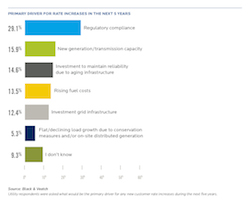According to Black & Veatch’s 8th annual Strategic Directions: U.S. Electric Industry report, many retiring nuclear and coal power plants may not need to be replaced on a megawatt-to-megawatt basis. With new technologies and distributed generation along with soft energy demand growth, utilities will be able to replace those retiring with ones that produce less energy.
“This year’s Strategic Directions: U.S. Electric Industry report finds many utilities at a crossroads,” said Dean Oskvig, president of Black & Veatch’s energy business. “The influx of new technologies, new energy sources and new generation approaches, create immense challenges and opportunities for utilities. What has not and will not change, however, is the mandate to deliver the ‘always on’ reliable electric service the
industry has provided for more than 100 years.”
 The report found that the rise of distributed generation in particular creates unique challenges for utilities. The technology requires rapid changes to the power grid in order to integrate new assets and resources. Utilities must also be able to ramp up capacity to account for varying renewable energy output (aka wind doesn’t always blow, the sun doesn’t always shine). Where distributed generation reduces demand, utilities will have to revisit their current revenue structure in order to ensure continued reliable service.
The report found that the rise of distributed generation in particular creates unique challenges for utilities. The technology requires rapid changes to the power grid in order to integrate new assets and resources. Utilities must also be able to ramp up capacity to account for varying renewable energy output (aka wind doesn’t always blow, the sun doesn’t always shine). Where distributed generation reduces demand, utilities will have to revisit their current revenue structure in order to ensure continued reliable service.
John Chevrette, president of Black & Veatch’s management consulting business, noted, “Every kilowatt that is now being produced by a third party or a consumer is a kilowatt not being sold by the utility. At the same time, utilities still carry the burden of building, maintaining and operating the bulk of the power delivery system. Given the high cost of maintaining these assets, we expect to see more utilities making the case with regulators to adjust their business models.”
Based on data collected by industry professionals across the U.S., the report tracks utility leaders’ views on a range of major issues. Some key findings include:
- Half of the respondents stated their company is planning to replace retiring coal and nuclear power plants with gas generation. Natural gas will also be used as backup power for renewable generation.
- Nearly 60 percent of utilities are updating emergency response plans in order to improve resiliency to weather and unanticipated events.
- Utilities are working to provide consumers with resources to better manage energy consumption. Almost one-third of utility respondents stated their organization is offering Home Area Network solutions, such as smart thermostats, to support demand response programs.
- More than 60 percent of utility leaders believe DG will grow beyond its current 5 percent market share of U.S. power generation by 2020.

